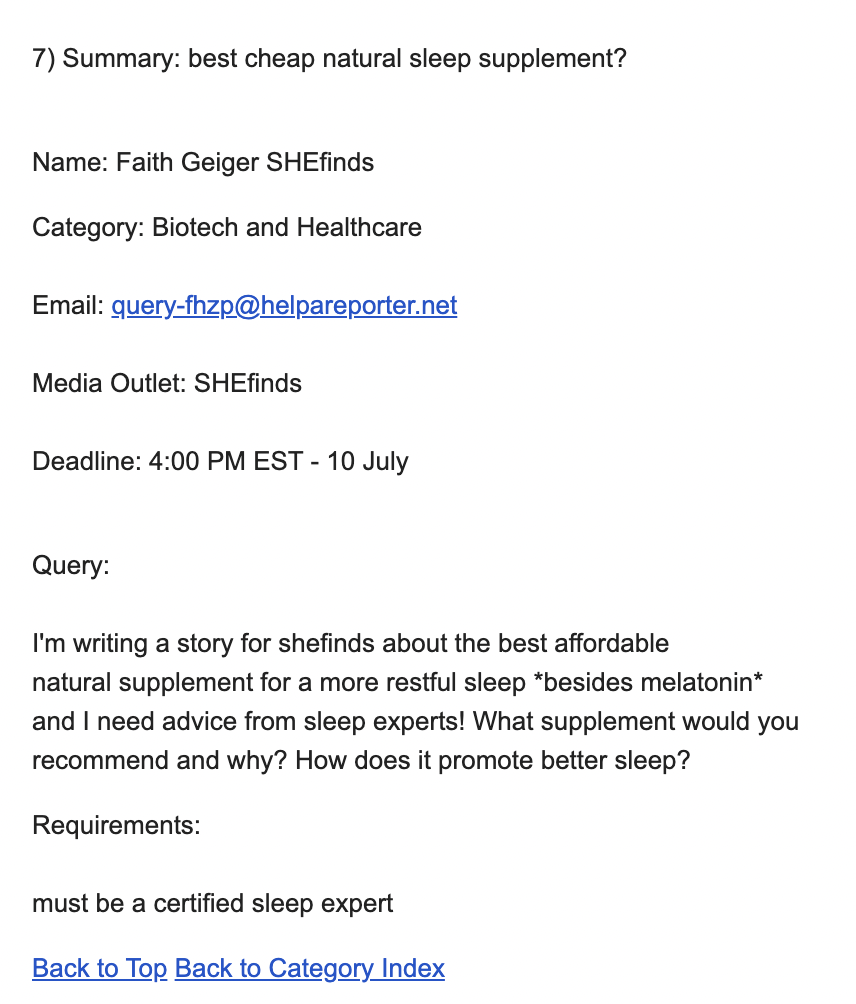
HARO (Help a Reporter Out) is an online PR platform that connects reporters and sources. It’s an easy quid pro quo system in which sources provide journalists and bloggers with quotes and information for their content in exchange for valuable media coverage.
From a digital marketing perspective, HARO is a great tool. It can help drive traffic from other websites to your brand, establishing it as a point of reference within the industry.
How to use HARO
Sign up
Although there are several paid memberships, the basic form of HARO is completely free to use and is enough. You can create an account by going to helpareporter.com and signing up as a source. This will take you to an overview of how the platform works, so you need to click on “sign up”, at the top navigation bar.
Once you have filled in the form with your details, you will receive an email to verify and set up your account. In your HARO preferences, you can select which industries you want to receive journalist queries from. We suggest selecting ‘Master HARO’ so that you receive everything in one master email, as sometimes fitting opportunities will come under an unexpected category.
Monitor the HARO emails
HARO sends out three emails a day. You will receive them at the same time each day, at 5.35 am EST, 12:35 pm EST, and 5:35 pm EST. (Important to remember it’s Eastern Standard Time, so these times will be different in the UK!)
When you receive the emails, here is an example of what they will look like:
 The queries will be organised by industry categories, and to see the full details you can click on them, or scroll down to the bottom of the email, where you will find them.
The queries will be organised by industry categories, and to see the full details you can click on them, or scroll down to the bottom of the email, where you will find them.
The number of queries will vary, so it’s important to keep an eye on all of the emails that come through to optimise the chance of finding ones relevant to you.
Start pitching
When you spot a query that seems relevant to your business, and you click on it to see the full details, it will look something like this:
 The name will have the journalist and publication in question, so you know where your quote will be used. However, some queries will be “anonymous”.
The name will have the journalist and publication in question, so you know where your quote will be used. However, some queries will be “anonymous”.
The email address is where you can send your pitch to. Make sure you’re always using the right one.
The deadline indicates the date and time by which you have to submit your pitch. Anything submitted to the email after this deadline will not be received by the journalist, as it will no longer be active.
The query specifies the questions that need information or the information they’d like you to provide a comment on. You must provide exactly what is requested, concisely and straightforwardly.
The requirements are specifics you need to meet, for the reporter to accept and use your comment. However, if you’re in doubt about whether you meet said requirements, it’s good to send out the pitch just in case.
Once you are happy with a query’s details, you can write up your pitch and send it out.
Monitor links
Due to the volume of sources on HARO, it can take a lot of pitching before you start getting some successful results. When you do, two things can happen:
- The reporter emails you back, notifying you that they will be using your pitch. Sometimes they may even email you the link, once the article quoting you is published.
- The reporter doesn’t email you back but uses your pitch.
In the second case, you will have received media coverage without being notified of it, which is why it is vital to regularly monitor potential links. You can do this by using Google search to find whether your comment has been used anywhere, or you can use various SEO online tools to find active links.
How to write a HARO pitch
Getting started on HARO is pretty easy, especially as the service is designed to be simple and intuitive. The most challenging part will be choosing the queries and then writing the pitches, and this is something that you can refine over time, with practice.
But to save you some hassle, here is an example of what a pitch should look like:
| Hi, reporter name,I saw your HARO request about (insert what the query was about), and (insert reason you are qualified for answering the query).
Insert your comment, answering the query in question Please attribute these comments to (insert details on your name, your brand/company, and the link you’d like them to include when quoting you) If you need anything else, I’m happy to help. Best wishes, your name |
This is just a basic template, which you should tweak based on your preferences, and the queries you’re answering. The important thing is to include your comment in the pitch, so the reporter has all the information they need from you straight away.
HARO tips
To get you started, here are some of our top tips that might help increase your chances of HARO success:
- Double-read a query before pitching.
Don’t waste your time pitching to queries unless they’re relevant to your business, and you meet the reporter’s requirements. It’s also vital that you read the query carefully, so you’re not going off-topic.
- Answer queries quickly.
Journalists receive a lot of pitches. The quicker you answer, the bigger the chance of your pitch getting picked, as simple as that.
- Be brief.
Your pitch shouldn’t look like an essay or article unless specifically requested by the reporter. Instead, be brief and concise, answering the questions without straying off-topic or over-writing. As a general rule, aim for under 250 words.
- Provide a bio and/or headshot.
In some cases, providing a short bio and/or a headshot of yourself can help your pitch look more appealing to a journalist. It helps provide more context as to how you qualify for providing a comment, and it solidifies you as a real source.
(If you provide a headshot, do it by linking the photo instead of attaching it to the email!)
- Keep track of your pitches.
Keeping track of the queries you want to answer and the pitches you’ve already sent out is a lot easier when you create a document or spreadsheet so make a note of things. This will also help you when it comes to monitoring potential links, as you’ll know what to look out for and where.
- Be patient.
It can take a long time before you start getting links through HARO. Reporters might use your pitch within days, or they might take as long as a few months, and they won’t always let you know. Keep submitting pitches and monitoring your links, consistency is key.
HARO isn’t a perfect platform, by all means.
However, it’s an accessible method for gaining brand visibility, especially if your pitches are successful with some of the high DR publications requesting commentary through the service.
It’s a great way to organically build up your site’s authority while establishing yourself as an industry expert, and although it can be time-consuming, it’s easy to use.
If you’d like to read other insightful articles on digital PR, SEO and more, you can find them in the It Works Media blog. Alternatively, if you’re looking for help with your marketing, get in touch, today.
